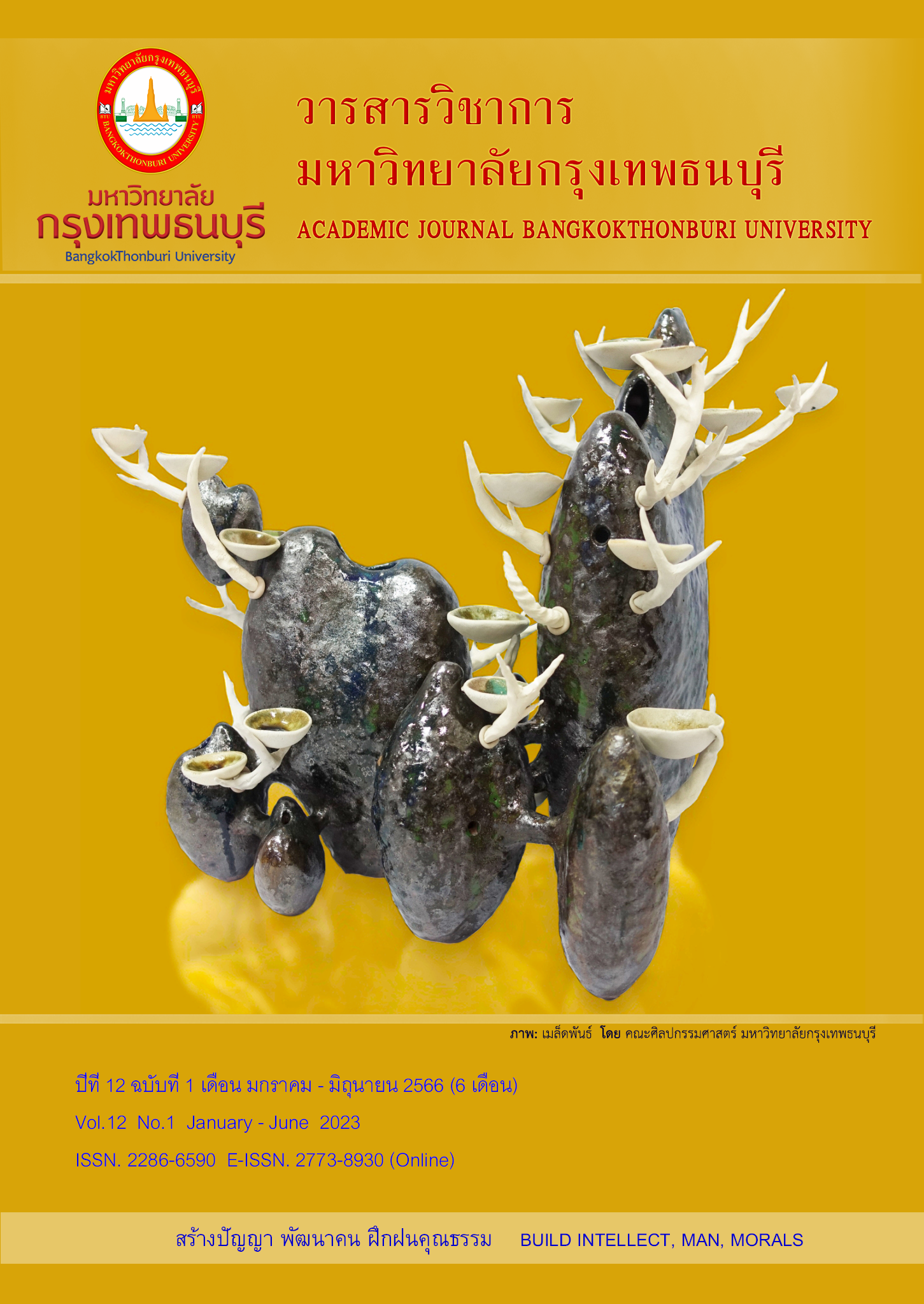Model of Competitive Advantage of Artificial Flower Entrepreneurs in Thailand
Main Article Content
Abstract
The purposes of this research were 1) to study the factors influencing the competitive advantage of artificial flower entrepreneurs in Thailand, 2) to analyze the relationship of the structural equation that influenced the competitive advantage of artificial flower entrepreneurs in Thailand. artificial flower business operators in Thailand 3) to create a competitive advantage model of artificial flower business operators in Thailand
This research was a mixed method research using stratified random sampling. From a population of 2,828 people, the sample size was determined according to the criteria of Hare et al. The sample group consisted of 340 entrepreneurs and executives. artificial flower business. The instrument used for data collection was a questionnaire. The statistics used in this research were percentage, mean, standard deviation. and structural equation model analysis by Lisrel program.
Major Findings: (1) When considering the influence of variables Characteristics of Entrepreneurship Customer Relationship Management Competitive advantage of artificial flower business in Thailand according to the factors studied Customer Relationship Management It has a positive direct influence on competitive advantage. has a direct influence value of 0.241 Entrepreneurial attributes It has a positive direct influence on competitive advantage. has an influence value of 0.033 service quality It has a positive direct influence on competitive advantage. has a direct influence value of 0.772 Customer Relationship Management It has a positive direct influence on competitive advantage. through service quality the direct influence was 0.241 and the indirect influence was 0.469. Entrepreneurial attributes It has a positive direct influence on competitive advantage. through service quality the direct influence was 0.033 and the indirect influence was 0.334. (2) Models of competitive advantages of artificial flower entrepreneurs in Thailand include Customer Relationship Management Entrepreneurial attributes service quality and the competitive advantage of entrepreneurs Customer Relationship Management Entrepreneurial attributes service quality and (3) the competitive advantage of operators. It has a positive influence on the competitive advantage of artificial flower entrepreneurs in Thailand. The index measures the level of consistency of the model (2= 234.613, df = 95,
2/ df = 2.469, p-value = 0.0517, CFI = 0.980, TLI = 0.971, RMSEA = 0.065, SRMR = 0.022) and (3) Competitive advantages of artificial flower entrepreneurs in Thailand are linked to each other.
Article Details

This work is licensed under a Creative Commons Attribution-NonCommercial-NoDerivatives 4.0 International License.
References
กรมพัฒนาธุรกิจการค้า กระทรวงพาณิชย์. (2565). สถิติการจดทะเบียนนิติบุคคลคงอยู่ในประเทศไทย.สืบค้นเมื่อ 1 มกราคม 2566 จาก http://datawarehouse.dbd.go.th/bdw/menu/est/1.html.
บุญชม ศรีสะอาด. (2561). หลักการวิจัยเบื้องต้น. (พิมพ์ครั้งที่ 9). กรุงเทพฯ: สุวิริยาสาส์น.
สุภมาส อังศุโชติ และคณะ. (2561). สถิติวิเคราะห์สำหรับการวิจัยทางสังคมศาสตร์และพฤติกรรมศาสตร์:เทคนิคการใช้โปรแกรม LISREL. (พิมพ์ครั้งที่ 3 ฉบับปรับปรุง). กรุงเทพฯ: เจริญดีมั่นคงการพิมพ์.
สุวิมล ติรกานันท์. (2557). ระเบียบวิธีการวิจัยทางสังคมศาสตร์: แนวทางสู่การปฏิบัติ. กรุงเทพมหานคร: สำนักพิมพ์แห่งจุฬาลงกรณ์มหาวิทยาลัย.
Almasi, F. & Pirzad, A. (2017). The Effect of Intellectual Capital and Knowledge Management on Competitive Advantage: Testing the Mediating Role of Customer Relationship Management. Journal of Economic & Management Perspectives, 11(3), 895-904.
Anwar, M. Khan, S. Z. & Khan, N. U. (2018). Intellectual Capital, Entrepreneurial Strategy and New Ventures Performance: Mediating Role of Competitive Advantage. Business and Economic Review, 10(1), 63-93.
Atilla, A. (2006). Measuring service quality in the hotel industry: A study in a business hotel in Turkey. International Journal of Hospitality Management, 25, 170-192.
Bryman, A. & Bell, E. (2001). Business Research Methods. (3rd ed.). (n.p): Oxford University.
Cui, Y., Sun, C., Xiao, H. and Zhao, C. (2016). How to become an excellent entrepreneur: The moderating effect of risk propensity on alertness to business ideas and entrepreneurial capabilities. Technological Forecasting and Social Change, 112, 171-177.
Ebrahimi, E., Fathi, M. R. & Irani, H. R. (2016). A new hybrid method based on fuzzy Shannon's Entropy and fuzzy COPRAS for CRM performance evaluation (Case: Mellat Bank). Iranian Journal of Management Studies, 9(2), 333-358.
Hair, J. F., Black, W. C., Babin, B. J., & Anderson, R. E. (2010). Multivariate data Analysis: A Global Perspective. (7th ed.). New Jersey: Pearson Education Inc.
Hatten, T. S. (2006). Small Business Management: Entrepreneurship and Beyond. (3rd ed.). Boston: Houghton Mifflin.
Jones, G. R. & George, M.J. (2003). Contemporary management. (9th ed.). New York: McGraw-Hill.
Mohammed, A. A. & Rashid, B. (2012). Customer Relationship Management: CRM in Hotel Industry: A Framework Proposal on the Relationship among CRM Dimensions, Marketing Capabilities, and Hotel Performance. International Review of Management and Marketing, 2(4), 220-230.
Morales, G. & Silvia, T. (2015). Factors of the entrepreneur's profile and the service quality management that influence firm survival. Barranquilla Jouranl, 38, 176-207.
Oztaysi, B. et al. (2011). A Measurement Tool for Customer Relationship Management Processs. Industrial Management & Data Systems, 11(6), 943-960.
Pantouvakis, A. & Mpogiatzidis, P. (2013). The impact of internal service quality and learning organization on clinical leaders' job satisfaction in hospital care services. Leadership in Health Services. Bradford, 26(1), 34-49.
Patel, N. & Bhatt, N. (2017). An Empirical Study on Integration of Seroquel and Kano Model for Measuring Service Quality of Hospitals in Ahmedabad. Indian Journal of Commerce and Management Studies, 8(3), 77-95.
Smith, D. (2006). Exploring Innovation. Berkshire: McGraw-Hill Education.
Tseng, S. (2016). Knowledge management capability, customer relationship management, and service quality. Journal of Enterprise Information Management, 29(2), 202-221.


